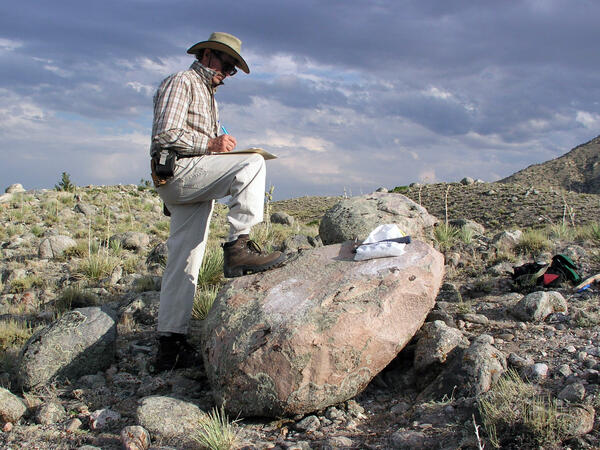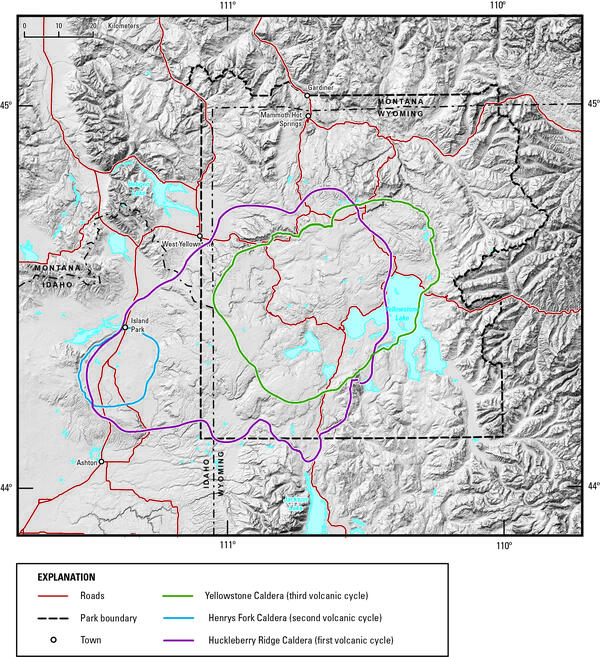Cross section through the trunk of a lodgepole pine tree from Cooking Hillside near Mud Volcano, Yellowstone National Park. The earliest date for this tree is 1916 and it died in 1990. Spongy white-gray areas are foam insulation that was injected into the sample to reinforce the structure of the wood.
Images
Images related to Yellowstone Volcano Observatory.

Cross section through the trunk of a lodgepole pine tree from Cooking Hillside near Mud Volcano, Yellowstone National Park. The earliest date for this tree is 1916 and it died in 1990. Spongy white-gray areas are foam insulation that was injected into the sample to reinforce the structure of the wood.

The Grey’s Landing Ignimbrite in Idaho (Dr. Thomas Knott, of the University of Leicester, England, gives the scale of the cliff). The entire cliff (and more not seen!) would have been deposited in a matter of moments as it welded to the land surface during a super eruption about 8.7 million years ago.
The Grey’s Landing Ignimbrite in Idaho (Dr. Thomas Knott, of the University of Leicester, England, gives the scale of the cliff). The entire cliff (and more not seen!) would have been deposited in a matter of moments as it welded to the land surface during a super eruption about 8.7 million years ago.

This two-image mosaic is one of the highest resolution views acquired by the Cassini spacecraft during its imaging survey of the geyser basin capping the southern hemisphere of Saturn's moon Enceladus.
This two-image mosaic is one of the highest resolution views acquired by the Cassini spacecraft during its imaging survey of the geyser basin capping the southern hemisphere of Saturn's moon Enceladus.

Photo of the Madison Museum, built in 1930 and designed by Herbert Maier. This structure exemplifies the National Park Rustic style, using natural materials and artisan craftmanship that are intended to blend buildings into the surrounding environment, “suggesting the smallness of man in relation to nature” (Herbert Maier).
Photo of the Madison Museum, built in 1930 and designed by Herbert Maier. This structure exemplifies the National Park Rustic style, using natural materials and artisan craftmanship that are intended to blend buildings into the surrounding environment, “suggesting the smallness of man in relation to nature” (Herbert Maier).
Overview of central West Thumb Geyser Basin. USGS photo by Pat Shanks, 2009.
Overview of central West Thumb Geyser Basin. USGS photo by Pat Shanks, 2009.

Ken Pierce in the field with a large glacial erratic in the Clarks Fork moraines taking detailed notes and annotating a map in progress.
Ken Pierce in the field with a large glacial erratic in the Clarks Fork moraines taking detailed notes and annotating a map in progress.

Ken Pierce, at the Curtis Canyon Overlook in Jackson Hole, leading the 2003 INQUA (International Union of Quaternary Research) field trip, one of his many geologic field trips about the Greater Yellowstone Geoecosystem.
Ken Pierce, at the Curtis Canyon Overlook in Jackson Hole, leading the 2003 INQUA (International Union of Quaternary Research) field trip, one of his many geologic field trips about the Greater Yellowstone Geoecosystem.

Bob Fournier measuring the gas-to-water ratio (gas/steam) at drill site Y2 in Yellowstone National Park
linkBob Fournier measuring the gas-to-water ratio (gas/steam) at drill site Y2, near Hot Lake on Firehole Lake Drive in Lower Geyser Basin, Yellowstone National Park, in the late 1960s. USGS Photo.
Bob Fournier measuring the gas-to-water ratio (gas/steam) at drill site Y2 in Yellowstone National Park
linkBob Fournier measuring the gas-to-water ratio (gas/steam) at drill site Y2, near Hot Lake on Firehole Lake Drive in Lower Geyser Basin, Yellowstone National Park, in the late 1960s. USGS Photo.
Yellowstone caldera viewed from Mount Washburn. The caldera is the low-lying area extending from the foothills of Mount Washburn in the foreground to the rugged mountains on the horizon. The incised valley of the Yellowstone River stretches from left to right in the middle distance. Steep valley walls are illuminated by sunlight in the center. 
Yellowstone caldera viewed from Mount Washburn. The caldera is the low-lying area extending from the foothills of Mount Washburn in the foreground to the rugged mountains on the horizon. The incised valley of the Yellowstone River stretches from left to right in the middle distance. Steep valley walls are illuminated by sunlight in the center. 

Hydrothermal explosion at Biscuit Basin in Yellowstone National Park. These types of events are the most likely explosive hazard from the Yellowstone Volcano.
Hydrothermal explosion at Biscuit Basin in Yellowstone National Park. These types of events are the most likely explosive hazard from the Yellowstone Volcano.
Schematic illustration of waterfall formation in which a hard rock that is more resistant to erosion is atop a softer rock that is less resistant to erosion. Source: Wikimedia (https://commons.wikimedia.org/wiki/File:WaterfallCreationDiagram.svg).
Schematic illustration of waterfall formation in which a hard rock that is more resistant to erosion is atop a softer rock that is less resistant to erosion. Source: Wikimedia (https://commons.wikimedia.org/wiki/File:WaterfallCreationDiagram.svg).

Yellow-bellied Marmot stands on its hind legs in Yellowstone National Park. Photo by D. Dzurisin.
Yellow-bellied Marmot stands on its hind legs in Yellowstone National Park. Photo by D. Dzurisin.
UNAVCO engineers drilling a borehole for instrument installation (left). Aerial view of borehole casing used to protect instruments from the elements found below the surface (right).
UNAVCO engineers drilling a borehole for instrument installation (left). Aerial view of borehole casing used to protect instruments from the elements found below the surface (right).

The water at Terrace Springs, northeast of Madison Junction in Yellowstone National Park, is relatively cold (about 60 °C or 140 °F), but the water is still saturated with CO2-rich bubbles. Photo by Shaul Hurwitz in September 2008.
The water at Terrace Springs, northeast of Madison Junction in Yellowstone National Park, is relatively cold (about 60 °C or 140 °F), but the water is still saturated with CO2-rich bubbles. Photo by Shaul Hurwitz in September 2008.

Roadcut in light pink ash-flow deposits of the Lava Creek Tuff on Grand Loop Road near Tuff Cliff. The color and closely spaced jointing are characteristic of the Lava Creek Tuff map unit. The steep faces and dense nature of the roadcut exposures indicate that a moderate degree of welding occurred and has not been subsequently modified by hydrothermal al
Roadcut in light pink ash-flow deposits of the Lava Creek Tuff on Grand Loop Road near Tuff Cliff. The color and closely spaced jointing are characteristic of the Lava Creek Tuff map unit. The steep faces and dense nature of the roadcut exposures indicate that a moderate degree of welding occurred and has not been subsequently modified by hydrothermal al

Lower Falls and Grand Canyon of the Yellowstone River. The river here is eroding young, post-caldera rhyolite that was softened by hydrothermal alteration. The V shape of the canyon indicates that the river is actively eroding in response to regional uplift. Photo by Richard Tollo, George Washington University, August 12, 2008.
Lower Falls and Grand Canyon of the Yellowstone River. The river here is eroding young, post-caldera rhyolite that was softened by hydrothermal alteration. The V shape of the canyon indicates that the river is actively eroding in response to regional uplift. Photo by Richard Tollo, George Washington University, August 12, 2008.

Narrow Gauge spring, Mammoth Hot Springs, Yellowstone National Park. Vent area is between the two trees on top of the travertine deposits. Terraced pools form due to deposition of travertine from the fluids as they cool and degas carbon dioxide.
Narrow Gauge spring, Mammoth Hot Springs, Yellowstone National Park. Vent area is between the two trees on top of the travertine deposits. Terraced pools form due to deposition of travertine from the fluids as they cool and degas carbon dioxide.
Left hand plot shows a focal mechanism from an earthquake where the fault is horizontal (red line), and the motion is right-lateral strike skip. The initial direction of wave motion (either back toward the source or away from the source is shown by the arrows. Right hand plot shows the associated beachball diagram, with compressional (“C”) and tensional
Left hand plot shows a focal mechanism from an earthquake where the fault is horizontal (red line), and the motion is right-lateral strike skip. The initial direction of wave motion (either back toward the source or away from the source is shown by the arrows. Right hand plot shows the associated beachball diagram, with compressional (“C”) and tensional

Digital elevation model of Yellowstone National Park and vicinity, showing the location of the calderas formed during each of Yellowstone’s three most recent volcanic cycles. The youngest caldera-forming eruption produced Yellowstone Caldera (green line), located within Yellowstone National Park.
Digital elevation model of Yellowstone National Park and vicinity, showing the location of the calderas formed during each of Yellowstone’s three most recent volcanic cycles. The youngest caldera-forming eruption produced Yellowstone Caldera (green line), located within Yellowstone National Park.

The contact (red arrow) between Huckleberry Ridge Tuff ignimbrite members B and C is marked by a time break of probably years to a few decades.
The contact (red arrow) between Huckleberry Ridge Tuff ignimbrite members B and C is marked by a time break of probably years to a few decades.

Southern tip of the Lemhi Range, eastern Snake River Plain. showing the wall of the Blue Creek caldera
linkSouthern tip of the Lemhi Range on the northeastern margin of the eastern Snake River Plain showing the caldera wall of the 6.27 million year old Blue Creek caldera, in the Heise volcanic field. Also shown are other units from the Heise volcanic field including the Kilgore Tuff and the Blacktail Creek Tuff. In the foreground is the much thicker sequence
Southern tip of the Lemhi Range, eastern Snake River Plain. showing the wall of the Blue Creek caldera
linkSouthern tip of the Lemhi Range on the northeastern margin of the eastern Snake River Plain showing the caldera wall of the 6.27 million year old Blue Creek caldera, in the Heise volcanic field. Also shown are other units from the Heise volcanic field including the Kilgore Tuff and the Blacktail Creek Tuff. In the foreground is the much thicker sequence






